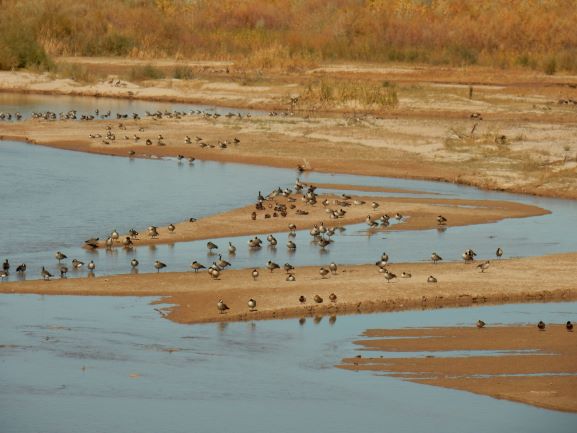The Museum is currently closed for renovations. Updates on the renovation will be available through the link Renovation Updates as well as through the museum's social media.
You are here
Chapter 4: River of Change

This chapter is devoted to creating a cloth and paper model of the river valley that provides a hands-on approach to understanding river and floodplain ecology in the Southwest. The basic activity, "Changing River," provides a setting for the subsequent activities that explore the roles of animals, plants, cottonwood trees, agriculture, and change in the river of the past (Rio Bravo), the present (Rio Manso), and the future (Rio Nuevo). By creating models of these three stages of the Rio Grande, the powerful teaching technique of contrast is used to clarify the role humans have played and can play in this river ecosystem.
Click Here to Download all of Chapter 4 (1.99 mB PDF)

Canada Geese on Rio Grande Sandbars- Photo by Mark Higgins
Chapter 4 Activities
Changing River: In a directed class activity, students construct a paper and cloth model of a section of the Rio Grande Valley as it was before major human intervention, and then manipulate it to demonstrate the human-caused changes over the last century. In the context of today’s river, the students contrast the differences between managing the river for only human benefits and managing the river with broader objectives of both ecosystem health and human needs. They then construct a model of the river of the future using those broader objectives.
The rest of the activities in Chapter 4 are based on the Changing River activity above. In practice we have found that these remaining activities work well alone, in separate sessions or combined together.
Cottonwood Creation: Students learn about cottonwood seedling survival. In Part One students identify the conditions a cottonwood seed needs to germinate (start growing) by tossing cotton balls on the river model. In Part Two, students use coins or dice as they try to grow seedling roots fast enough to keep up with a lowering water table. Students realize that very few cottonwood seeds actually become trees and that altered river conditions are very limiting for cottonwood establishment. This activity delves into a specific example of a species and its survival—what allows a species to continue to exist in its location.
Who Lives Where?: Students explore animals’ niches in bosque habitats using the Changing River model and see how human-caused changes to the bosque impact the ability of animals to survive and thrive over time. A section discussing threatened and endangered animals and introduced and non-native species is included. There are 48 native and 10 introduced bosque animal species illustrated with detailed natural history information.
Who Grows Where?: Students explore plants and the role plants play in the bosque ecosystem using the Changing River model and see how human-caused changes to the bosque impact the ability of plants to survive and thrive over time. There are 25 native and non-native bosque plant species illustrated with detailed natural history information.
Working Water: Concentrating on the agricultural aspect of the Middle Rio Grande Valley, students create an irrigation system on the Changing River model, expanding on and exploring human influence on the Rio Grande created in the Rio Manso river model.
Bosque Chaos: By the roll of dice, students use the Changing River model to see how chance influences natural and human-caused changes in the bosque.
Click Here to Download all of Chapter 4 (1.99 mB PDF)
Activities
- Changing River (1.36mB PDF)*
- Cottonwood Creation (214 kB PDF)*
- Who Lives Where? ( 1.65mB PDF)*
- Who Grows Where? (614 kB PDF)*
- Working Water (610 kB PDF)*
- Bosque Chaos (1.25mB PDF)*
*Next Generation Science Standards- NM STEM Ready! Science Standards Aligned
A Note about Science Standards
The Chapter 4 River of Change activities are correlated with New Mexico STEM Ready! Science Standards; these include both the national Next Generation Science Standards (NGSS) and New Mexico-specific performance expectations. These are highlighted in three places:
1. Standards are listed at the beginning of each activity in a call-out “Standards Box”.
2. Specific questions and prompts help students critically think about the concept to be addressed. The appropriate Disciplinary Core Idea (DCI) code, Crosscutting Concept (CCC) and/or Science and Engineering Process (SEP) that relate to each concept are highlighted directly in the text.
3. At the end of each activity, there are more detailed entries addressing how the activity particularly helps students with that specific DCI.
New Mexico STEM Ready! Performance Expectations for 5th grade and middle school fit into our scope and new connections specifically addressing these standards are included.
Appendix K (358 kb PDF) shows which activities address which standards.
Chapter 4 includes detailed information cards and illustrations for the following animals and plants that live in the Middle Rio Grande Valley.
Animals
Animals are found in the Who Lives Where? activity pdfs, pages 202-233
Who Lives Where? Rio Bravo: Native Animals
Common Name / Scientific Name
Arthropods
- Mayfly Baeti sp.
- Field Cricket Gryllus sp.
- Plains Cicada Megatibicen dealbates
- Caddisfly Hydropsyche sp.
- Harvester Ant Pogonomyrmex sp.
- Leaf-roller Anacampis innocuella
- Mosquito many spp.
Fish
- Shovelnose Sturgeon Scaphirhynchus platorynchus
- Rio Grande Bluntnose Shiner Notropis simus simus
- Red Shiner Cyprinella lutrensis
- Rio Grande Silvery Minnow Hybognathus amarus
Amphibians
- Western Chorus Frog Pseudacris triseriata
- Northern Leopard Frog Lithobates pipiens
Reptiles
- Western Painted Turtle Chrysemys picta
- Spiny Softshell Turtle Apalone spinifera
- New Mexico Whiptail Aspidoscelis neomexicanus
- Bullsnake Pituophis catenifer
- Gartersnake Thamnophis sp.
Birds
- Canada Goose Branta canadensis
- Mallard Anas platyrhynchos
- Greater Roadrunner Geococcyx californianus
- Yellow-billed Cuckoo Coccyzus americanus
- Sandhill Crane Antigone canadensis
- Killdeer Charadrius vociferous
- Great Blue Heron Ardea herodias
- Cooper’s Hawk Accipiter cooperii
- Bald Eagle Haliaeetus leucocephalus
- Great Horned Owl Bubo virginianus
- Belted Kingfisher Ceryle alcyon
- Southwestern Willow Flycatcher Empidonax traillii extimus
- American Crow Corvus brachyrhynchos
- Summer Tanager Piranga rubra
- Red-winged Blackbird Agelaius phoeniceus
Mammals
- Desert Cottontail Sylvilagus audubonii
- Little Brown Bat Myotis lucifugus
- Beaver Castor canadensis
- Botta’s Pocket Gopher Thomomys bottae
- New Mexico Meadow Jumping Mouse Zapus luteus luteus
- Muskrat Ondatra zibethicus
- White-footed Mouse Peromyscus leucopus
- North American Porcupine Erethizon dorsatum
- Coyote Canis latrans
- Mule Deer Odocoileus hemionus
Who Lives Where? Rio Bravo: Upper Watershed, Native Animals
- Rio Grande Cutthroat Trout Oncorhynchus clarki virginalis
- Osprey Pandion haliaetus
- American Dipper Cinclus mexicanus
- Black Bear Ursus americanus
- Elk Cervus elaphus
Who Lives Where? Rio Manso: Animals Introduced to the Middle Rio Grande
- Isopods: Pillbug and Sowbug Armadillidium vulgare and Porcellio laevis
- Carp Cyprinus carpio
- Mosquitofish Gambusia affinis
- Bullfrog Lithobates catesbeiana
- European Starling Sturnus vulgaris
- House Sparrow Passer domesticus
- House Mouse Mus musculus
- Feral Dogs and Cats Canis lupus familiaris and Felis catus
Who Lives Where? Rio Manso: Upper Watershed, Introduced Animals
- Rainbow Trout Oncorhynchus mykiss
- Brown Trout Salmo trutta
Plants
Plants are found in the Who Grows Where? activity pdfs, pages 249-261
Who Grows Where? Rio Bravo: Native Plants
Common Name / Scientific Name
- Rio Grande cottonwood Populus deltoides subsp.wislizeni
- New Mexico olive Forestiera pubescens
- Coyote willow Salix exigua
- One-seeded juniper Juniperus monosperma
- False indigo Amorpha fruticosa
- Western white clematis Clematis ligusticifolia
- Screwbean mesquite Prosopis pubescens
- Wolfberry Lycium pallidum
- Prickly pear Opuntia spp.
- Giant sacaton Sporobolus wrightii
- Sedge Carex spp.
- Saltgrass Distichlis spicata
- Smooth scouring rush or horsetails Equisetum laevigatum
- Yerba mansa Anemopsis californica
- Hooker’s evening primrose Oenothera hookeri
- Broad-leaved cattail Typha latifolia
- Sacred datura Datura wrightii
- Sunflower Helianthus annuus
- Spectacle pod Dimorphocarpa wislizeni
Who Grows Where? Rio Manso: Plants Introduced to the Middle Rio Grande
- Saltcedar Tamarix chinensis
- Tree of heaven Ailanthus altissima
- White sweet clover Melilotus alba
- Russian olive Elaeagnus angustifolia
- Cheatgrass Bromus tectorum
- Kochia Kochia scoparia
Spanish Activities
Who Lives Where Spanish Cards/¿Quíen vive dónde?
Who Grows Where Spanish Cards/¿En dónde crecen estas plantas?
Revisions, Spring 2020/2022
Funding from: New Mexico Department of Game and Fish, Share With Wildlife Fund
- Writing Group: Letitia Morris, Lisa Ellis, Karen Herzenberg, Stephanie Kircher, Molly Madden, Kelly White, Laurel Ladwig, Layout
- Advisory Group: Selena Connealy, Aryn LaBrake, Heather MacCurdy, Deb Novak, Jennifer Owen-White
- Contributors: Reese Bice, illustrations, Katie Elder, Matt Schmader
- Reviewers: Delfine Baca, Eric Griffin, Amy Grochowski, Candy Hodoba, Ani Jamgyal, Joan Morrison, Virginia Seamster, Fiana Shapiro, Storm Usrey



